Produce Primer: Artichoke Hearts
Posted by Jill | March 18, 2010 | Filed under: Home, Ingredients
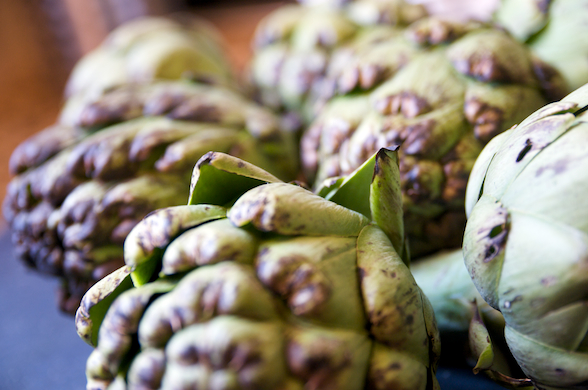 This is what a motley artichoke looks like. After sitting on my counter for three days, their leaves dried out a bit, but their hearts were still wonderful. They’re still beautiful to me because I know how wonderful they are on the inside. Oh no. Am I talking about a vegetable or having a moment of self-examination?
This is what a motley artichoke looks like. After sitting on my counter for three days, their leaves dried out a bit, but their hearts were still wonderful. They’re still beautiful to me because I know how wonderful they are on the inside. Oh no. Am I talking about a vegetable or having a moment of self-examination?
Its artichoke season! Do you know what this means?! Do you? Do you? This is the beginning of the year’s good produce. We’ve made it through the doldrums of January and February. Another head of cabbage anyone? We can now begin the countdown to local asparagus- but we’re not rushing through artichokes.
Though the season technically runs from March through May, we just started getting good-looking ‘chokes that aren’t absurdly expensive. I just paid 89-cents each for 10 slightly motley but quite large ones. No one is more excited about this development than my Sally, whose love for the prickly, leathery flowers is legendary.
I know lots of folks love to steam them or stuff them, but we are all about getting right to the heart. I can’t be bothered to suck tiny amounts of goodness from the bottoms of leathery leaves. There is something decadent about getting through all the leaves to claim the rich, tender heart. It isn’t too difficult. It just takes courage, a sharp chef’s knife and a sharp paring or utility knife, and a little practice.
Selection
You’re looking for artichokes that are a lovely green with fresh looking “leaves” (actually, petals). You generally want to avoid ‘chokes that have dry-looking leaves with brownish spots or edges. That said- because I’m going straight for the heart- I will happily take advantage of a sale on brownish artichokes. I haven’t found that the hearts are much affected by dry leaves. The only thing you want to check in this situation is the stem end. The brownness means they’re older and you’ll occasionally get rot at the base- which does affect the heart. If you do ever get a ‘choke with a rotten spot, just trim it out.
Finally, as a general rule, the bigger and rounder the artichoke, the bigger the heart. Hmm, that’s often true of people, too. Isn’t it? This is especially important because artichokes are often priced by unit rather than weight.
Storage
The ideal storage situation is the fridge. However, if you buy 10 artichokes and plan to store them in your fridge, you’ll need quite a bit of space. I will often just put them in a basket on the counter out of the way of direct sunlight. I’ll need to use them within three days or they’ll get pretty shabby.
Prep
Juice a lemon into a bowl, tossing in the juiced lemon for good measure. Fill the bowl with 1 ½ cups water. Keep the cut hearts in the water as they will turn brown very quickly. The only consequence of brownness is that they look much prettier in a lovely shade of beige-green than mottled brown.

Step 2: Slice through the leaves to expose the choke- the fluffy stuff inside. That's about 1- 2" from the base. You're just really looking for a flat surface to work on.
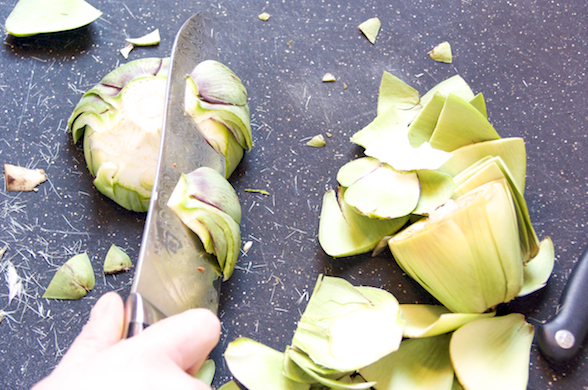
Step 3: Place the artichoke with the stem-end facing up. Using your knife, trim around the circumference of the base to remove the outer leaves and expose the heart.
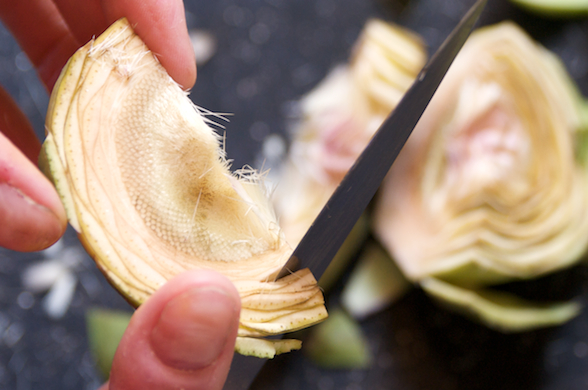
Step 4: Cut the heart in half or in quarters. Use a paring or utility knife to trim off the upper rim of leaves. Some folks leave them there. I find them too tough so I just take 'em off.
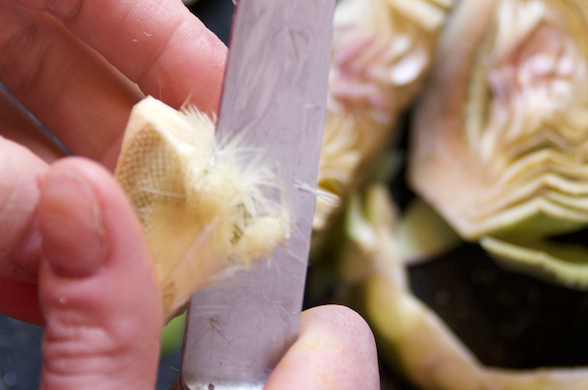
Step 5: Remove that fluffy choke with a paring knife. You may still see a "dotty" bit at the bottom. Don't worry about it. You're done!
Cook & Serve
Give them a final rinse to be certain you’ve gotten all of the fluffy choke off. Cut them on a cleaned cutting board into the size and shape you want them to be when served. If sautéed or roasted, they lose maybe 20% of their volume. If boiled or steamed, they retain their size. Here are a few suggestions:
- Cut the heart in eighths and sauté them over medium-high heat with a bit of garlic and shallot- taking care not to burn the garlic. Serve with freshly grated Parmesan.
- Toss quartered hearts in a small bit of olive oil and roast them in a 425-degree oven until tender, maybe 12 minutes. Finish them with a bit more olive oil, some freshly Microplaned lemon zest, freshly grated pepper, salt and a little squeeze of lemon juice. Again, a bit of Parmesan would be nice.
- Again using pieces of heart cut into eighths, toss them into salted boiling water at the same time you add orzo or other very small pasta. Both will be finished at the same time. How’s that for easy?
- Make a fantastic appetizer by cutting hearts into ¼” chunks and cooking them, covered, in the microwave with a tablespoon of water until they’re tender. Mix them with some chopped roasted red bell pepper and chopped kalamata olives (Pit them yourself! The texture of a pre-pitted olive really suffers. Oh fine. Buy the pitted ones if you’re short on time.) Mix in a bit of garlic and a generous amount of freshly-grated Parmesan. Add sparing amounts of Microplaned lemon zest, finely chopped oil-packed sundried tomato, and either freshly chopped parsley, basil, oregano or even thyme. Spoon onto toasted bread rounds and bake in a 325-degree oven until cheese is melted and topping is warm.

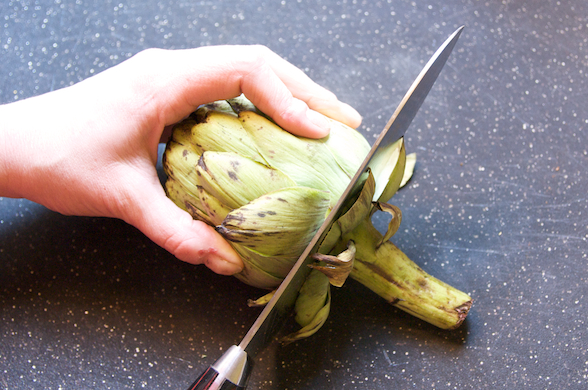



Great question. The heart is really the base of the artichoke. You take off the stem and the leaves and all the fluff (called the “choke”) and then you’ve got the heart. Another way I might describe it is that it is the only really “meaty” part of the artichoke. Everything else is fibrous fluff and leaves. Does that make sense?
If you’re interested but nervous about it, buy one or two artichokes. Open them up as I’ve instructed. It’ll make more sense as you handle the artichoke. When you’ve gotten to the heart (or what you believe is the heart) you can steam them in the microwave or cook them in boiling water for to enjoy for yourself. That way you won’t have too much pressure not to mangle them!
Just remember, the heart really is just a tiny bit of the artichoke. You might hold that bit in your hand thinking, “I mustn’t have done this right. I have so little left.” But when you taste it, you’ll get it. It is worth it!
HI,
After reading this article about Artichokes once, I am still not clear on what the heart of an artichoke is – is it the fluffy stuff?